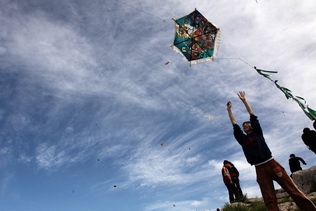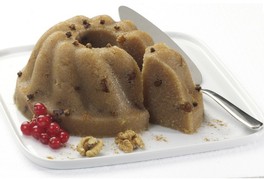KALI SARAKOSTI!
 Fresh 'lagana' with sesame or chopped olives. Yumm (foto emmakay)
Fresh 'lagana' with sesame or chopped olives. Yumm (foto emmakay) Today the whole country celebrates the religious public holiday of Clean Monday (Greek: Καθαρά Δευτέρα – Kathara Deftera), and is the start of what we call “the Clean Week” here in Greece. This is the first week of the seven weeks before Easter, and by tradition the forty-plus days of fasting that the Orthodox believers will subject themselves to. Greek Cyprus too celebrates this day with a public holiday and similar traditions.
The theme of Clean Monday is based on the Scriptures (Isaiah 1:1-20):
Wash yourselves and ye shall be clean; put away the wicked ways from your souls before Mine eyes; cease to do evil; learn to do well. Seek judgment, relieve the oppressed, consider the fatherless, and plead for the widow. Come then, and let us reason together, saith the Lord: Though your sins be as scarlet, I will make them white as snow; and though they be red like crimson, I will make them white as wool (v. 16-18).
(On a side note: Remarkable here is the fact that the symbolic colours of red and white are also reflected in the traditional Martenitsi (see my post on 1 March - Chestita Baba Marta) which are handed out in Greece’s northern neighbour Bulgaria as symbols marking the beginning of Spring, although I have not come across any reference material that would actually link the latter to the Scriptures.)
Back to Greece, though.
It is also customary during this week to carry out what is known as Spring Cleaning, and it is a widespread tradition that all houses and dwellings in general receive a thorough going-through during this week. In the villages where traditions are upheld even more strictly, you’ll find people whitewashing or painting the walls of their houses, while inside the house it’s the time that cupboards, wardrobes and drawers are cleaned and freshened up.
Yesterday, Sunday was the last day of Carnival, the last day that in many traditional Greek Orthodox families people will have eaten meat or any animal by-product. Instead, it’s customary to revert to Lent food.
 Kites high up the sky! (foto courtesy of Frosso!)
Kites high up the sky! (foto courtesy of Frosso!)  Seafood galore (foto downloaded)
Seafood galore (foto downloaded)  The soft halva... heaven on a plate!
The soft halva... heaven on a plate! To finish the meal in style, dessert is halva, either the soft semolina-like pudding with cinnamon and almonds or the harder Makedoniko variety, made from tahini and which tastes delicious with some sprinkles of lemon and cinnamon! It also comes with cocoa or almonds... I can never decide which of the two very different varieties I prefer more... they're both absolutely yummy!
 Kira Sarakosti - Lady Lent
Kira Sarakosti - Lady Lent Another traditional curiosity related to this special period on the Greek religious calendar is Lady Lent, a figure who is an important part of the seven weeks of lent: Kira Sarakosti, her Greek name, is a small figure baked of bread dough which features something really unusual: she has seven legs and her hands are folded as if in prayer. Lady Lent’s seven legs each represent one week of the fasting period. There is a cross on her forehead, and she has no mouth, indicating that she can’t eat because she is fasting. In modern Greek households the actual act of baking this figure has started to disappear, instead being replaced by children cutting the woman figure from cardboard. It is customary to place Kira Sarakosti near the icon centre which every Greek home has, and each Sunday in Lent that passes, one of her legs will be removed. In other words, Lady Lent serves like some kind of calendar for the countdown to Pascha – the Greek Easter, and undoubtedly the biggest family feast of the religious year. Lady Lent will lose her last leg on the Saturday before Easter...
We shall be returning to our village down by the sea later on in the hope that the weather gods show some mercy, allowing me to take some pictures of kites high in the sky as well as capturing some of the locals and visitors enjoying a good time together, casting aside the harsh realities of life at the moment...
Let me sign off for today in the hope that we can all find that forgiveness in our hearts that would allow us to have not only a Clean Monday, but as much of a Clean Year as is humanly possible...
Καλή Σαρακοστή! (pronounce ka-lee sarakos-tee!) Happy Lent to all of you...
Smiles
Emm xx


 RSS Feed
RSS Feed
